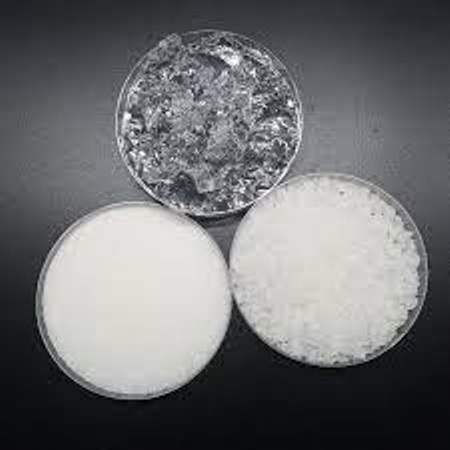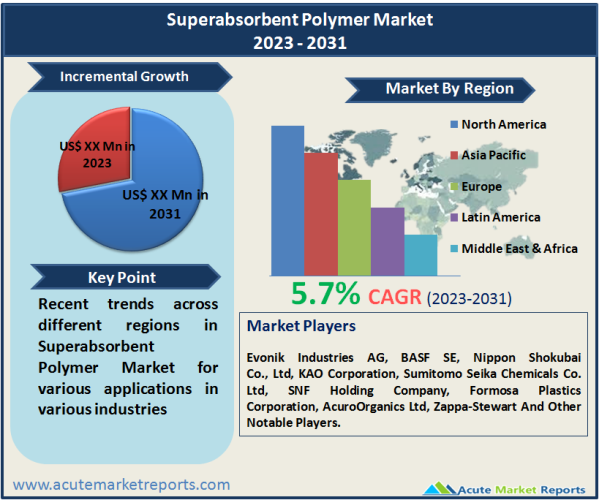
Superabsorbent polymers (SAPs) are a class of synthetic materials known for their exceptional ability to absorb and retain large quantities of water or aqueous solutions. These polymers are used in a wide range of applications where the absorption and retention of liquids are critical. SAPs have gained prominence in industries such as hygiene products, agriculture, packaging, medical devices, and construction due to their unique properties.Superabsorbent polymers market is expected to expand at a CAGR of 5.7% from 2025 to 2033, driven by its versatile applications and sustainability initiatives. While challenges related to raw material availability exist, the market's expansion is expected to continue into the forecast period from 2025 to 2033. As industries continue to prioritize eco-friendly solutions and explore innovative applications, superabsorbent polymers are poised to play a pivotal role in addressing water

Increasing Demand in Hygienic Applications
The demand for superabsorbent polymers in hygienic applications has witnessed substantial growth, primarily driven by the personal care and hygiene industry. Superabsorbent polymers are a key component in products like diapers, adult incontinence products, and feminine hygiene products. In 2024, the global population continued to grow, resulting in an increased need for these products. Additionally, consumers' focus on convenience and performance has driven the adoption of superabsorbent polymer-based products. The ability of SAPs to absorb and retain large volumes of liquid, preventing leakage and providing a dry and comfortable experience, has made them indispensable in the hygiene industry. This trend is expected to continue into the forecast period (2025-2033), further boosting the growth of the superabsorbent polymer market.
Expanding Non-Hygienic Applications
Superabsorbent polymers are finding new and innovative applications beyond hygiene products. The non-hygienic applications of SAPs have been expanding in industries such as agriculture, packaging, and construction. In agriculture, SAPs are used in water-absorbing soil conditioners and agricultural films to improve water retention in soil and reduce irrigation frequency. In packaging, SAPs are employed in products like absorbent pads and trays to extend the shelf life of fresh produce and meat by absorbing excess moisture. The construction industry also utilizes SAPs in concrete to enhance its workability, reduce shrinkage cracks, and improve durability. In 2024, the growing awareness of water conservation and sustainability drove the adoption of SAPs in these non-hygienic applications. As industries continue to innovate and seek environmentally friendly solutions, the demand for superabsorbent polymers is expected to increase, driving market growth.
Focus on Sustainability and Environmental Concerns
Sustainability has become a significant driver in the superabsorbent polymer market. With increasing environmental concerns, both consumers and industries are seeking products that are eco-friendly and reduce their carbon footprint. Superabsorbent polymers, when used in specific applications, can help reduce water consumption, decrease waste, and improve resource efficiency. For example, in agriculture, SAPs reduce the need for frequent irrigation, conserving water resources. In hygiene products, the development of biodegradable SAPs is gaining attention, addressing concerns about product disposal. In 2024, sustainability initiatives and regulations pushed industries to explore sustainable alternatives, creating opportunities for eco-friendly superabsorbent polymers. This trend is expected to continue into the forecast period, with SAP manufacturers focusing on greener solutions to meet evolving industry and consumer demands.
Challenges in Raw Material Availability
Superabsorbent polymers are primarily derived from raw materials such as acrylic acid and acrylamide. The availability and pricing of these raw materials can fluctuate due to various factors, including supply chain disruptions, geopolitical issues, and feedstock availability. In 2024, the superabsorbent polymer market faced challenges related to the procurement and cost of raw materials, impacting production costs and pricing. Additionally, the demand for acrylic acid, a crucial component of SAPs, is influenced by other industries like adhesives, paints, and textiles, further affecting its supply for SAP production. Ensuring a consistent and cost-effective supply of raw materials is essential to mitigate this restraint as the market moves into the forecast period.
Sodium Polyacrylate Dominates the Market by Raw Material
The superabsorbent polymer market can be segmented based on the type of raw materials used in their production. Sodium Polyacrylate is a type of SAP which is widely used in hygiene products due to its excellent water-absorbing capacity.Similar to sodium polyacrylate, potassium polyacrylate is used in various applications, including agriculture and packaging.Polyacrylamide Copolymer SAPs are used in specialized applications, including medical products and water treatment.Ethylene Maleic Anhydride Copolymer SAP is used in agriculture and horticulture applications to improve water retention in soil.Polysaccharides biodegradable SAPs derived from natural sources, such as starch and cellulose, are gaining popularity in sustainable products.In terms of both compound annual growth rate (CAGR) and revenue, sodium polyacrylate dominated the market in 2024, primarily due to its widespread use in hygienic applications.
Hygienic Applications Dominates the Market by Application
Hygienic Applications includes products such as diapers, adult incontinence products, and feminine hygiene products.Non-hygienic applications encompass agriculture, packaging, construction, and other innovative uses.In 2024, hygienic applications accounted for the highest revenue share due to their established market presence. However, non-hygienic applications exhibited the highest CAGR, driven by sustainability initiatives and the development of innovative products.
North America Remain as a Global Leader
Geographic trends in the superabsorbent polymer market reflect variations in demand and growth across regions. Asia-Pacific is expected to exhibit the highest CAGR during the forecast period, driven by the rapid expansion of the personal care and agriculture sectors in countries like China and India. In terms of revenue percentage, North America is expected to maintain its position as the leading region in 2024, owing to its well-established hygiene product industry and sustainable agriculture practices. Additionally, Europe is anticipated to witness significant growth, fueled by increasing awareness of water conservation and sustainability.
Competitive Trends
The superabsorbent polymer market features several key players, including Evonik Industries AG, BASF SE, Nippon Shokubai Co., Ltd, KAO Corporation, Sumitomo Seika Chemicals Co. Ltd, SNF Holding Company, Formosa Plastics Corporation, AcuroOrganics Ltd, and Zappa-Stewart. These companies employ various strategies to maintain their market position and drive growth. Key strategies include product innovation, research and development investments, and sustainability initiatives. In 2024, these top players collectively generated substantial revenue, and they are expected to continue leading the market throughout the forecast period. The competitive landscape remains dynamic, with players focused on developing advanced SAP formulations, improving production efficiency, and addressing sustainability challenges.
Historical & Forecast Period
This study report represents analysis of each segment from 2023 to 2033 considering 2024 as the base year. Compounded Annual Growth Rate (CAGR) for each of the respective segments estimated for the forecast period of 2025 to 2033.
The current report comprises of quantitative market estimations for each micro market for every geographical region and qualitative market analysis such as micro and macro environment analysis, market trends, competitive intelligence, segment analysis, porters five force model, top winning strategies, top investment markets, emerging trends and technological analysis, case studies, strategic conclusions and recommendations and other key market insights.
Research Methodology
The complete research study was conducted in three phases, namely: secondary research, primary research, and expert panel review. key data point that enables the estimation of Superabsorbent Polymer market are as follows:
Market forecast was performed through proprietary software that analyzes various qualitative and quantitative factors. Growth rate and CAGR were estimated through intensive secondary and primary research. Data triangulation across various data points provides accuracy across various analyzed market segments in the report. Application of both top down and bottom-up approach for validation of market estimation assures logical, methodical and mathematical consistency of the quantitative data.
| ATTRIBUTE | DETAILS |
|---|---|
| Research Period | 2023-2033 |
| Base Year | 2024 |
| Forecast Period | 2025-2033 |
| Historical Year | 2023 |
| Unit | USD Million |
| Segmentation | |
Raw Material
| |
Application
| |
|
Region Segment (2023-2033; US$ Million)
|
Key questions answered in this report